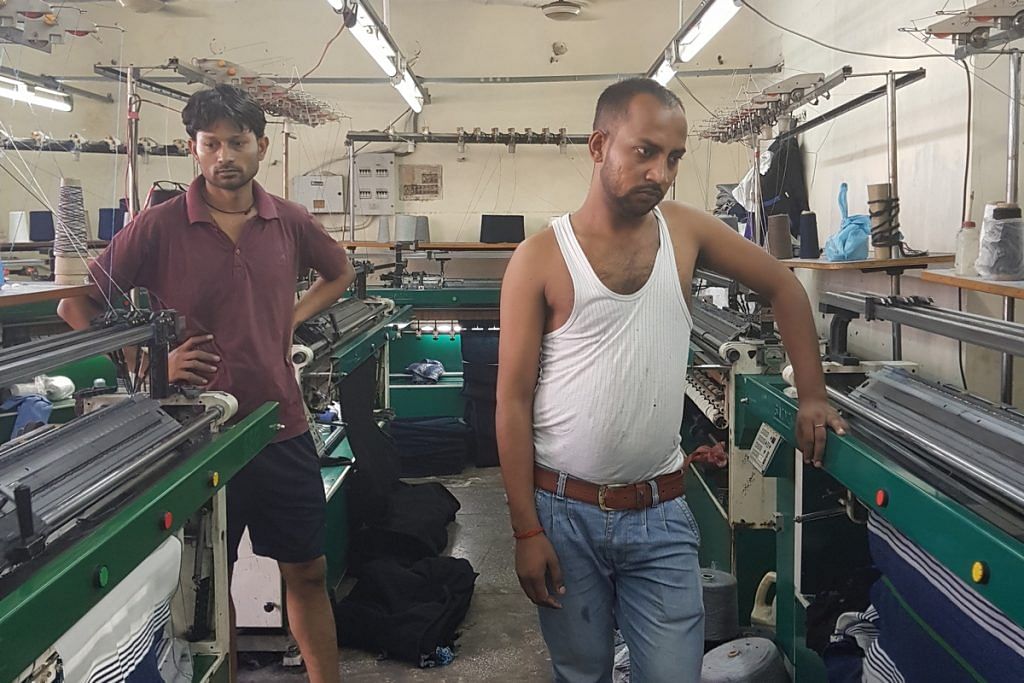Daily labourers are worst affected, but permanent employees could also lose jobs as GST hits 12,000 hosiery units in the Ludhiana area.
Ludhiana: Manga Ram is proud that he works each day of each month. Despite his young age of 26, he’s an old hand in a hosiery factory in Ludhiana. But something around him has changed.
“There were 80-90 men working with me in this factory. Now there are only 50,” Manga Ram says.
First came demonetisation, then the Goods and Services Tax (GST). Now, the hosiery industry in Ludhiana is beginning to show signs of grave distress. A labour-intensive industry, it used to employ over four lakh workers, but 30 per cent of them have left looking for jobs elsewhere.
“Labourers have gone back to Uttar Pradesh and Bihar, where they came from. There is not enough work for them here,” says Manga Ram.
Ludhiana is home to almost 12,000 hosiery units, totalling an annual turnover of Rs 14,000 crore. But according to Darshan Dawar, president of Knitwear Club, the association of hosiery owners, this may not be the case for much longer, since business is down by 25 to 30 per cent.
“There are many small units which are holding on till this winter. If the season goes well, smaller units might remain afloat. But if demand falls further and order cancellations continue, more than 2,000 units will be closed by the end of the year,” he warns.
The trouble hasn’t hit the likes of Manga Ram, who is among the permanent employees in his factory. However, casual labourers hired to handle the extra seasonal workload or supplement trained workers are no longer needed.
Dawar says, “Daily wage jobs in the hosiery sector shrank following demonetisation, and this year there has been a further cut. We are getting fewer orders, and pending orders have been cancelled. Production has been affected, and in my unit alone, I have had to shunt out 25 daily labourers we employed.”
But permanent employees may yet lose their jobs, warns Dawar.
“Till now, we have retained our permanent staff, even while there is little or no work for them. We are hoping that the situation will improve. If we throw them out, we will have to later look for skilled men. But if no changes are announced for the hosiery sector, especially for the small- and medium-scale units, full time workers too stand to lose their jobs,” he adds.
Adverse impact of GST
Hosiery units claim that the imposition of GST has forced them to increase the selling price of their products. Also, there is now a need for larger amounts of working capital and cash in hand, which has pushed smaller or marginal hosiery owners off the map.
Dawar, whose Sunhill Knitware located in Bajwa Nagar manufactures knitted sweaters and pullovers, says: “I have had to increase the cost of my products by Rs 50 to Rs 100 a piece, and the buyers have refused to touch my products.”
The unorganised hosiery sector used to carry out business on a system of credit.
“Payments were made when the finished product was sold and we received payments. Now, the raw material cost plus its tax has to be paid for at the time of its purchase, for which we are taking loans at high interest rates. It takes time to produce and sell, and payments of the sale can take even longer,” explains Dawar.
“It might work out for those who have large scale units, but for small or micro units, taking bank loans and paying a huge amount of interest for months could mean end of their business.”
The cost increase is being attributed to the high GST on thread or yarn. It was earlier taxed at 3 per cent, and is now taxed at 5 to 12 per cent, reduced from the slab of 18 per cent on 6 October, following a meeting of the GST council.
Also read: Fewer footfalls & fall in demand take a toll on Mumbai’s jewellery workforce
“Before GST, the thread, which is a mix of acrylic and nylon, was available at Rs 350 per kg. Last week, the rate has been increased to Rs 405 per kg,” says Kapil Joshi, who runs E-marc hosiery products.
“The thread mills have created cartels and are quoting unrealistic prices. I cannot pass on the increase to my customer, as there is already a shortage of demand because of demonetisation. As a result, I have cut down on my margins. We are not sure that the reduction in GST on some yarns announced on Friday will lead to reduction in rates of raw materials,” Joshi adds.
Another factor affecting the industry is the GST imposed on job work.
“Suits, sarees, sweaters etc. pass through some hand work and machine work processes done by artisans. They work from home, are not trained, and don’t have big set ups,” explains Sonu Nilibar, coordinator of the Cloth Merchant Association of Ludhiana.
“These artisans are mostly illiterate and rarely keep accounts. Even if they are not in the GST net because they fall in the less than Rs 20 lakh category, to get bills from them is almost impossible,” he adds.
